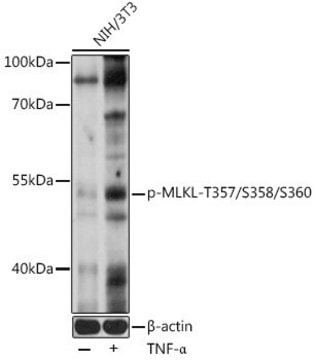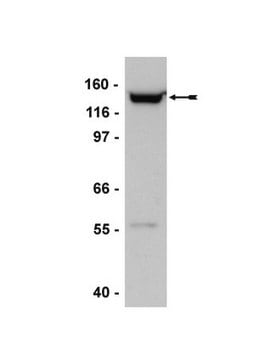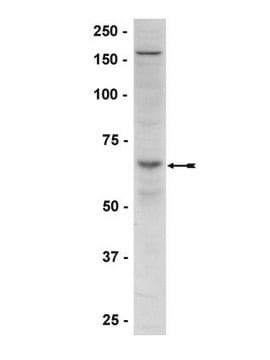15-115
AMPK Pathway Explorer Antibody MiniPack
1 mg/mL, Upstate®
Sinônimo(s):
AMP-Activated Protein Kinase
About This Item
Produtos recomendados
fonte biológica
rabbit
Nível de qualidade
forma do anticorpo
purified antibody
tipo de produto de anticorpo
primary antibodies
clone
polyclonal
reatividade de espécies
rat (07-350SP, 07-363SP, 07-681SP), mouse (07-350SP), human (07-350SP, 07-363SP, 07-681SP)
fabricante/nome comercial
Upstate®
concentração
1 mg/mL
técnica(s)
activity assay: suitable (kinase and phosphatase)
western blot: suitable
nº de adesão UniProt
Condições de expedição
dry ice
Informações sobre genes
human ... PRKAA1(5562)
mouse ... Hsf3(245525)
Descrição geral
Each Pathway Explorer Antibody Minipack contains three related antibodies as part of a signaling cascade or a combination of total and phosphorylated forms of key signaling targets. Each of the three antibodies are 30% the original pack size. Full size versions of each of the Pathway Explorer antibodies are available for sale individually under the same catalog number with the removal of “SP” off of each one (e.g. 05-591SP can be ordered as 05-591).
AMPK:
AMP-activated protein kinase (AMPK) is a metabolic and stress-sensing kinase that regulates homeostasis, and a key target for treating Type 2 diabetes and obesity. AMPK exists as a heterotrimeric complex comprised of catalytic alpha subunits (62 kDa) and non-catalytic beta and gamma subunits. Alpha subunit has at least two isoforms (alpha 1 and alpha 2) which differ in their subcellular localization and AMP-dependence. AMPK is phosphorylated by upstream kinases, AMPK Kinase (AMPKK) and LKB1 which results in its activation. Active AMPK regulates metabolism by phosphorylating rate-limiting enzymes in metabolic pathways and controlling gene expression. Phosphorylation of threonine 172 in the activation loop of the alpha subunit is a key determinant of AMPK activity.
*See full size versions for corresponding references.
Especificidade
07-363SP: AMP-Activated Protein Kinase alpha 2 (AMPKα2).
07-350SP: AMPKα1
Varies. See individual Data Sheets
Imunogênio
Aplicação
Signaling
Apoptosis & Cancer
Insulin/Energy Signaling
Embalagem
Componentes
07-363SP Anti-AMPKα2; 60 µg
07-681SP Anti-phospho-AMPKα (Thr172); 60 µg
Qualidade
Western Blot Analysis:
0.5-2 μg/mL of this lot detected phospho-AMPK α in RIPA lysates from overnight serum starved HEK293 cells and partially purified rat liver AMPK. Signal was reduced after treatment of lysate with λ-phosphatase.
07-363SP: Routinely evaluated by immunoblot in a rat liver preparation.
Western Blot Analysis:
1-2 μg/mL of this lot detected AMPK α2 in a rat liver preparation.
07-350SP: Routinely evaluated by immunoblot in RIPA lysates from non-stimulated A431 cells.
Western Blot Analysis:
0.5-2 μg/mL of this lot detected AMPK α1 in RIPA lysates from non-stimulated A431 cells.
Descrição-alvo
forma física
Armazenamento e estabilidade
Handling Recommendations: Upon receipt, and prior to removing the cap, centrifuge the vial and gently mix the solution. Aliquot into microcentrifuge tubes and store at -20°C. Avoid repeated freeze/thaw cycles, which may damage IgG and affect product performance. Note: Variability in freezer temperatures below -20°C may cause glycerol-containing solutions to become frozen during storage.
Nota de análise
For 07-681SP use HEK293 cells or rat liver AMPK.
For 07-363SP use Rat liver preparation.
For 07-350SP use A431cell lysate, or lysate of HeLa cells treated with heat shock.
Informações legais
Exoneração de responsabilidade
Not finding the right product?
Try our Ferramenta de seleção de produtos.
Código de classe de armazenamento
10 - Combustible liquids
Certificados de análise (COA)
Busque Certificados de análise (COA) digitando o Número do Lote do produto. Os números de lote e remessa podem ser encontrados no rótulo de um produto após a palavra “Lot” ou “Batch”.
Já possui este produto?
Encontre a documentação dos produtos que você adquiriu recentemente na biblioteca de documentos.
Nossa equipe de cientistas tem experiência em todas as áreas de pesquisa, incluindo Life Sciences, ciência de materiais, síntese química, cromatografia, química analítica e muitas outras.
Entre em contato com a assistência técnica








